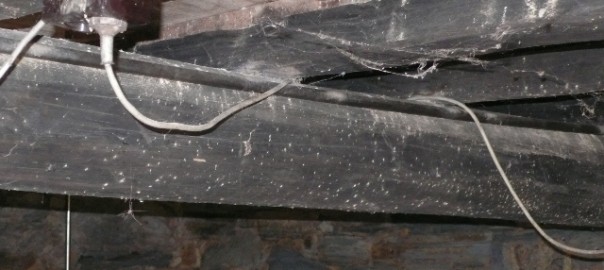Woodworm in Portugal
Woodworm in Portugal Warm weather, untreated timbers and lots of forestry is woodworm heaven in Portugal Let’s have a closer look at the enemy. The Common Furniture Beetle (Anobium punctatum). Despite its name, Common Furniture Beetle is just as likely to attack building timbers (joists, floorboards, etc…) as it is to attack furniture. This species of woodworm can be identified by the small, round holes that are left on the surface of the timber (approx. 1.5 – 2mm diameter) and the bore-dust that it leaves behind – showing up as lemon-shaped pellets under magnification and feeling “gritty” when rubbed between the fingers. The adult beetle (see below) is typically between 3 and 5mm long.  A key identifying feature is the distinctly-shaped thorax – giving the appearance of a Darth Vader helmet (star wars) over the beetle’s head. Other types of woodworm common here include the Death-watch Beetle (Xestobium rufuvillosum), the House Longhorn Beetle (Hylotrupes bajulus), and the Powder post beetle (Lyctus brunneus). Whilst the Powder Post Beetle can be treated in much the same way as the Common Furniture Beetle, House Longhorn and Death-watch Beetle infestations require more extensive treatment – Most commonly available woodworm treatments contain permethrin as its active ingredient. This has been selected because it has proven effectiveness against all life cycle stages of common woodworm species (eggs, larvae, and adult beetles).
A key identifying feature is the distinctly-shaped thorax – giving the appearance of a Darth Vader helmet (star wars) over the beetle’s head. Other types of woodworm common here include the Death-watch Beetle (Xestobium rufuvillosum), the House Longhorn Beetle (Hylotrupes bajulus), and the Powder post beetle (Lyctus brunneus). Whilst the Powder Post Beetle can be treated in much the same way as the Common Furniture Beetle, House Longhorn and Death-watch Beetle infestations require more extensive treatment – Most commonly available woodworm treatments contain permethrin as its active ingredient. This has been selected because it has proven effectiveness against all life cycle stages of common woodworm species (eggs, larvae, and adult beetles).
- Apply by coarse high pressure spray or dipping.
- High-strength formulation.
- Solvent-free.
- Stable once mixed.
- Targets all life cycle stages.
Common Furniture Beetle Attacks softwood (Pine, Spruce) and the sapwood of European hardwoods. Rarely causes obvious structural weakening although tunneling along the grain of the wood over time can cause extensive collapse and invite other wood pests to invade the timber. House Longhorn Beetle Only attacks the sapwood of softwood timbers. As softwood is often used in roof timbers, infestation can often result in severe structural weakening. Powder Post Beetle Causes damage to hardwood with a high starch content, such as ash, elm and oak. Older timbers (over 15 years old) don’t provide a suitable environment for this species. Tunnels along the grain and can cause severe damage, often infesting block or parquet flooring. Death-Watch Beetle Prefers European hardwoods, especially oak, ash and chestnut that have been “softened” by partial decay. Decay normally caused by previous problems with wet or dry rot. The larvae tend to tunnel towards the center of the timber, so that damage may be more extensive than is apparent from the exterior. What treatments are available? So you’ve found evidence of woodworm. Before deciding on a treatment, you should:
- Identify the species.
- Determine whether the infestation is still active.
- Employ a timber specialist to determine which timbers have been structurally weakened and need replacing.
Timber that has been structurally weakened will have to be removed and replaced with pre-treated timber. Other affected woodwork will then need to be treated. Professional advice is recommended for the treatment of larger scale infestations and certainly for removal and replacement of timbers. Talk to info@casteloconstruction.com or skype him on casteloconstruction to chat about your woodworm problems.
Woodworm in Portugal


